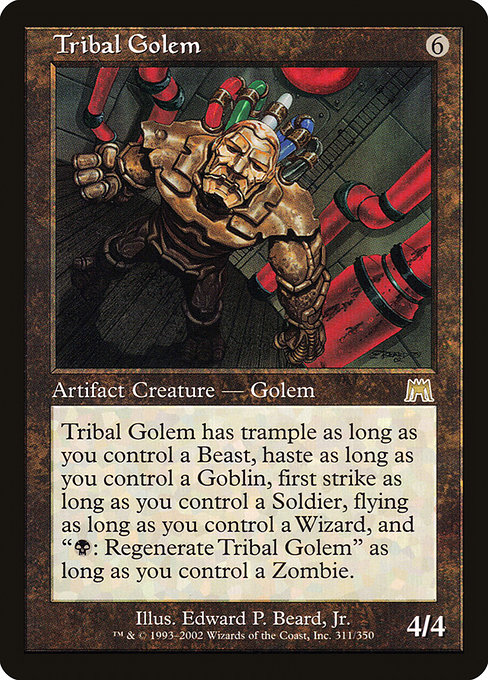
Image courtesy of Scryfall.com
Haste as a Catalyst for Tribal Golem Deck Archetypes
Back in the Onslaught era, a single artifact creature could spark a surprisingly resilient multi-tribal strategy. Tribal Golem is a 6-mana, 4/4 artifact creature that plays nicely with the word “tribal” because its abilities reference several distinct creature families. The card’s flavor is part of the charm: it actively benefits from the presence of a Beast, a Goblin, a Soldier, a Wizard, and a Zombie. The result is a playground for community-driven archetypes where haste, first strike, flying, trample, and regeneration aren’t just generic keywords—they’re unlocks that tilt a battlefield in new, surprising directions. 🧙♂️🔥💎
This creature has trample as long as you control a Beast, haste as long as you control a Goblin, first strike as long as you control a Soldier, flying as long as you control a Wizard, and "{B}: Regenerate this creature" as long as you control a Zombie.
What makes Tribal Golem so compelling isn’t simply its 6-mana stickiness; it’s the way its conditional permissions invite players to assemble surprisingly coherent sub-arcs within a black-leaning, multi-tribal shell. Yes, the Golem is colorless at heart, but its color identity is Black, which opens a lane for a midrange, attrition-heavy game plan where the Golem can be a central threat while other tribes stitch together the necessary enablers. The community has long enjoyed pushing artifact creatures into unusual routes, and this one casts a wide net that rewards creative deckbuilding—especially around haste in a world where black is often careful, controlling, and surgical rather than outright fast. ⚔️🎨
Archetype: Goblin-Driven Haste Golem
Haste is the marquee ability here, and it’s delivered the moment you can claim a Goblin on the board. In a black-leaning shell, Goblin acceleration and aggression get the Golem into the red zone with minimal fuss. The core idea is to create a small-but-rapid battlefield where Tribal Golem swings through on turn six (often sooner with acceleration) and threatens to push through damage before opponents can stabilize. Goblin enablers may also provide chump-block insurance or short-term mana bursts that let you hope for a single explosive combat step. The result is a sweaty, popcorn-burst kind of start—fast, chaotic, and delightfully retro. 🔥💎
Archetype: Beast-Driven Trample Line
On the surface, beasts adding trample to a 4/4 proves you don’t need a colossal boss to make big plays. Beast synergy turns the Golem into a surprisingly resilient behemoth, capable of punching through stalled defenses and leveraging large, rampy bodies to push through damage when the ground game is clogged. The community often pairs Beasts with beefy creatures that can step up the board and keep the pressure on while Tribal Golem sustains the tempo with trample. The payoff isn’t merely damage—it’s the satisfaction of watching a well-timed trampling attack collapse a stalemate into a decisive moment. 🧙♂️⚔️
Archetype: Zombie Regeneration Safety Net
Black’s natural resilience comes into play with the Zombie trigger. When you control a Zombie, the Golem can regenerate for a much-needed cushion against removal. That regenerative cost—black mana for a shield—fits neatly into a longer grind plan where you’re trading resource for resource and keeping the Golem alive to threaten again and again. In practice, this leads to slower, more deliberate sequences where you squeeze value from every shielded swing and every regeneration step, turning a once-fragile artifact into a durable late-game threat. 🧟♂️💎
Archetype: Wizard Wings and Flying Adds
Flying gives Tribal Golem an extra dimension, especially when the board is crowded with ground blockers. Wizards can unlock that mobility, and community builds often explore the flying route as a way to dodge ground-based removal and threaten from unexpected angles. The Golem’s flyer synergy becomes a game of cat-and-meline, where you tilt the air war in your favor and keep opponents guessing about how you’ll push through. It’s a classic, elegant dance of tempo and reach that feels both strategic and satisfying. 🪶🧙♀️
Archetype: Soldier First Strike Sparks
First strike on a Golem is a rare thrill, and Soldiers provide the exact edge you need to unsettle opponents who rely on big blockers. When your Golem gains first strike via a Soldier trigger, you convert some of your midrange pressure into precise, efficient damage. This archetype often embraces a disciplined approach: time removal, protect the Golem, and maximize the value of first-strike damage in combat math. It’s the quiet finesse of black-leaning tribal play, with the Golem as a stubborn centerpiece that refuses to fold. ⚔️
Community-driven builds thrive on the balance between tempo and value. A successful Tribal Golem deck often includes a careful mix of enablers that satisfy its five tribe conditions, a selection of removal and disruption to keep the Golem alive, and a few sneaky ways to recur key pieces from the graveyard. The interplay between these tribes—Beast, Goblin, Soldier, Wizard, and Zombie—gives you multiple lines of attack and defense, making the deck feel larger than its actual card pool. And yes, you’ll want to lean into the nostalgia of early-2000s design while keeping a modern edge through efficient removal and value-generating creatures. 🧙♂️🔥
As you brew, consider a calm, cozy play surface for extended sessions—the kind of setup you’d find in a dedicated craft-minded hobby corner. Speaking of craft, a reliable desk setup makes long nights of theorycrafting and playtesting that much more enjoyable. If you’re looking to level up the vibe between rounds, the Gaming Neon Mouse Pad 9x7 with Custom Stitched Edges can be a perfect companion for marathon evenings. It’s a small touch, but those small touches accumulate into memorable gaming sessions. Happy brewing! 🧙♂️🎲
Gaming Neon Mouse Pad 9x7 - Custom Stitched Edges
More from our network
- https://blog.digital-vault.xyz/blog/post/ai-assisted-synergy-prediction-for-historian-of-zhalfir-decks/
- https://blog.digital-vault.xyz/blog/post/evolution-of-orzhov-enforcer-interpretations-across-mtg-players/
- https://transparent-paper.shop/blog/post/designing-notion-dashboards-a-practical-guide/
- https://blog.digital-vault.xyz/blog/post/from-pen-to-pixel-the-future-of-digital-stationery-and-paper-crafting/
- https://transparent-paper.shop/blog/post/mastering-marketing-automation-with-zapier-for-growth/